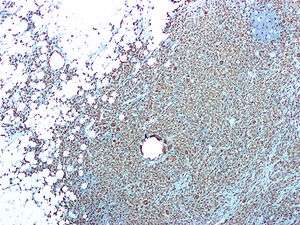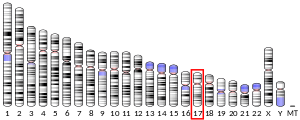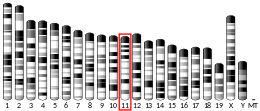CD68
CD68 (Cluster of Differentiation 68) is a protein highly expressed by cells in the monocyte lineage (e.g., monocytic phagocytes, osteoclasts), by circulating macrophages, and by tissue macrophages (e.g., Kupffer cells, microglia).[5]
| CD68 | |||||||||||||||||||||||||
|---|---|---|---|---|---|---|---|---|---|---|---|---|---|---|---|---|---|---|---|---|---|---|---|---|---|
| Identifiers | |||||||||||||||||||||||||
| Aliases | CD68, GP110, LAMP4, SCARD1, CD68 molecule | ||||||||||||||||||||||||
| External IDs | OMIM: 153634 MGI: 88342 HomoloGene: 955 GeneCards: CD68 | ||||||||||||||||||||||||
| |||||||||||||||||||||||||
| |||||||||||||||||||||||||
| Orthologs | |||||||||||||||||||||||||
| Species | Human | Mouse | |||||||||||||||||||||||
| Entrez | |||||||||||||||||||||||||
| Ensembl | |||||||||||||||||||||||||
| UniProt | |||||||||||||||||||||||||
| RefSeq (mRNA) | |||||||||||||||||||||||||
| RefSeq (protein) | |||||||||||||||||||||||||
| Location (UCSC) | Chr 17: 7.58 – 7.58 Mb | Chr 11: 69.66 – 69.67 Mb | |||||||||||||||||||||||
| PubMed search | [3] | [4] | |||||||||||||||||||||||
| Wikidata | |||||||||||||||||||||||||
| |||||||||||||||||||||||||

Structure and function
Human CD68 is a transmembrane glycoprotein, heavily glycosylated in its extracellular domain, with a molecular weight of 110 kD. Its primary sequence consists of 354 amino acids with predicted molecular weight of 37.4 kD if it were not glycosylated.[6] The human CD68 protein is encoded by the "CD68" gene which maps to Chromosome 17.[7] Other names or aliases for this gene in humans and other animals include: CD68 Molecule, CD68 Antigen, GP110, Macrosialin, Scavenger Receptor Class D, Member 1, SCARD1, and LAMP4.[7][8] The mouse equivalent is known as "macrosialin".
CD68 is functionally and evolutionarily related to other gene/protein family members, as follows:[6][8][9]
- the hematopoietic mucin-like family of molecules that includes leukosialin/CD43 and stem cell antigen CD34;
- the lysosomal/endosomal-associated membrane glycoprotein (LAMP) family, CD68 localizes primarily to lysosomes and endosomes but with a smaller fraction circulating to the cell surface;
- the scavenger receptor family which typically function to clear cellular debris, promote phagocytosis, and mediate the recruitment and activation of macrophages.
Use in pathology and research
Immunohistochemistry can be used to identify the presence of CD68, which is found in the cytoplasmic granules of a range of different blood cells and myocytes. It is particularly useful as a marker for the various cells of the macrophage lineage, including monocytes, histiocytes, giant cells, Kupffer cells, and osteoclasts. This allows it to be used to distinguish diseases of otherwise similar appearance, such as the monocyte/macrophage and lymphoid forms of leukaemia (the latter being CD68 negative). Its presence in macrophages also makes it useful in diagnosing conditions related to proliferation or abnormality of these cells, such as malignant histiocytosis, histiocytic lymphoma, and Gaucher's disease.[10][11]
Anti-CD68 monoclonal antibodies that react with tissues of rodent and other species include ED1, FA-11, KP1 (a.k.a. C68/684), 6A326, 6F3, 12E2, 10B1909, and SPM130. Monoclonals that react with humans include, Ki-M7, PG-M1, 514H12, ABM53F5, 3F7C6, 3F7D3, Y1/82A, EPR20545, CDLA68-1, LAMP4-824.[12]
ED1
ED1 is the most widely used monoclonal antibody clone directed against the rat CD68 protein and is used to identify macrophages, Kupffer cells, osteoclasts, monocytes, and activated microglia in rat tissues.[13][14][15] In this species, it is expressed in most macrophage populations and thus ED1 is commonly used as a pan-macrophage marker.[16] However, in some cell types it is detectable only when up-regulated, such as activated but not quiescent microglia, and can thus be used as a marker of inflammatory conditions and immune reactions in those instances. Commercial suppliers report that ED1 is used for detection of the CD68 protein by immunohistochemical staining, flow cytometry, and western blot methods and that in addition to rat it cross-reacts with bovine species.
The ED1 anti-CD68 antibody is not to be confused with the fibronectin extra domain ED1.[17]
See also
References
- GRCh38: Ensembl release 89: ENSG00000129226 - Ensembl, May 2017
- GRCm38: Ensembl release 89: ENSMUSG00000018774 - Ensembl, May 2017
- "Human PubMed Reference:". National Center for Biotechnology Information, U.S. National Library of Medicine.
- "Mouse PubMed Reference:". National Center for Biotechnology Information, U.S. National Library of Medicine.
- Holness CL, Simmons DL (March 1993). "Molecular cloning of CD68, a human macrophage marker related to lysosomal glycoproteins". Blood. 81 (6): 1607–13. doi:10.1182/blood.V81.6.1607.1607. PMID 7680921.
- "CD68 - Macrosialin precursor - Homo sapiens (Human) - CD68 gene & protein". www.uniprot.org. Retrieved 16 September 2017.
- "CD68 Symbol Report". www.genenames.org. Retrieved 16 September 2017.
- "CD68 Gene - CD68 Protein - CD68 Antibody". www.genecards.org. Retrieved 16 September 2017.
- "MACROPHAGE ANTIGEN CD68; CD68". omim.org. Retrieved 16 September 2017.
- Leong, Anthony S-Y; Cooper, Kumarason; Leong, F Joel W-M (2003). Manual of Diagnostic Cytology (2 ed.). Greenwich Medical Media, Ltd. pp. 135–136. ISBN 1-84110-100-1.
- Manduch M, Dexter DF, Jalink DW, Vanner SJ, Hurlbut DJ (January 2009). "Undifferentiated pancreatic carcinoma with osteoclast-like giant cells: report of a case with osteochondroid differentiation". Pathology, Research and Practice. 205 (5): 353–9. doi:10.1016/j.prp.2008.11.006. PMID 19147301.
- "Product Overview: anti-CD68 Antibodies". www.antibodies-online.com. Retrieved 14 September 2017.
- Dijkstra CD, Döpp EA, Joling P, Kraal G (March 1985). "The heterogeneity of mononuclear phagocytes in lymphoid organs: distinct macrophage subpopulations in the rat recognized by monoclonal antibodies ED1, ED2 and ED3". Immunology. 54 (3): 589–99. PMC 1453512. PMID 3882559.
- Gomes LF, Lorente S, Simon-Giavarotti KA, Areco KN, Araújo-Peres C, Videla LA (2004). "Tri-iodothyronine differentially induces Kupffer cell ED1/ED2 subpopulations". Molecular Aspects of Medicine. 25 (1–2): 183–90. doi:10.1016/j.mam.2004.02.018. PMID 15051326.
- Xie R, Kuijpers-Jagtman AM, Maltha JC (February 2009). "Osteoclast differentiation and recruitment during early stages of experimental tooth movement in rats". European Journal of Oral Sciences. 117 (1): 43–50. doi:10.1111/j.1600-0722.2008.00588.x. PMID 19196317.
- Damoiseaux JG, Döpp EA, Calame W, Chao D, MacPherson GG, Dijkstra CD (September 1994). "Rat macrophage lysosomal membrane antigen recognized by monoclonal antibody ED1". Immunology. 83 (1): 140–7. PMC 1415006. PMID 7821959.
- Vincent PA, Rebres RA, Lewis EP, Hurst V, Saba TM (November 1993). "Release of ED1 fibronectin from matrix of perfused lungs after vascular injury is independent of protein synthesis". The American Journal of Physiology. 265 (5 Pt 1): L485-92. doi:10.1152/ajplung.1993.265.5.L485. PMID 8238536.
Further reading
- Human Gene Database: GeneCards CD68
- UniProt Knowledgebase (CD68_HUMAN)
- Luo C, Kallajoki M, Gross R, Mulari M, Teros T, Ylinen L, Mäkinen M, Laine J, Simell O (November 2002). "Cellular distribution and contribution of cyclooxygenase COX-2 to diabetogenesis in NOD mouse". Cell and Tissue Research. 310 (2): 169–75. doi:10.1007/s00441-002-0628-6. PMID 12397372.
- O'Reilly D, Quinn CM, El-Shanawany T, Gordon S, Greaves DR (June 2003). "Multiple Ets factors and interferon regulatory factor-4 modulate CD68 expression in a cell type-specific manner". The Journal of Biological Chemistry. 278 (24): 21909–19. doi:10.1074/jbc.M212150200. PMID 12676954.
- Le BH, Boyer PJ, Lewis JE, Kapadia SB (July 2004). "Granular cell tumor: immunohistochemical assessment of inhibin-alpha, protein gene product 9.5, S100 protein, CD68, and Ki-67 proliferative index with clinical correlation". Archives of Pathology & Laboratory Medicine. 128 (7): 771–5. doi:10.1043/1543-2165(2004)128<771:GCTIAO>2.0.CO;2 (inactive 2020-01-22). PMID 15214825.
- Mazur G, Haloń A, Wróbel T, Kuliczkowski K (2004). "Macrophage/histiocytic antigen CD68 expression in neoplastic and reactive lymph nodes". Roczniki Akademii Medycznej W Bialymstoku. 49 Suppl 1: 73–5. PMID 15638380.
- Kunz-Schughart LA, Weber A, Rehli M, Gottfried E, Brockhoff G, Krause SW, Andreesen R, Kreutz M (2003). "[The "classical" macrophage marker CD68 is strongly expressed in primary human fibroblasts]". Verhandlungen der Deutschen Gesellschaft Fur Pathologie (in German). 87: 215–23. PMID 16888915.
- Kim JS, Romero R, Cushenberry E, Kim YM, Erez O, Nien JK, Yoon BH, Espinoza J, Kim CJ (2007). "Distribution of CD14+ and CD68+ macrophages in the placental bed and basal plate of women with preeclampsia and preterm labor". Placenta. 28 (5–6): 571–6. doi:10.1016/j.placenta.2006.07.007. PMID 17052752.
- O'Reilly D, Greaves DR (September 2007). "Cell-type-specific expression of the human CD68 gene is associated with changes in Pol II phosphorylation and short-range intrachromosomal gene looping". Genomics. 90 (3): 407–15. doi:10.1016/j.ygeno.2007.04.010. PMID 17583472.
- Lee CH, Espinosa I, Vrijaldenhoven S, Subramanian S, Montgomery KD, Zhu S, Marinelli RJ, Peterse JL, Poulin N, Nielsen TO, West RB, Gilks CB, van de Rijn M (March 2008). "Prognostic significance of macrophage infiltration in leiomyosarcomas". Clinical Cancer Research. 14 (5): 1423–30. doi:10.1158/1078-0432.CCR-07-1712. PMID 18316565.
- Chen WS, Chen CH, Lin KC, Tsai CY, Liao HT, Wang HB, Chen YK, Yang AH, Chen TC, Chou CT (2009). "Immunohistological features of hip synovitis in ankylosing spondylitis with advanced hip involvement". Scandinavian Journal of Rheumatology. 38 (2): 154–5. doi:10.1080/03009740802409504. PMID 19165649.



